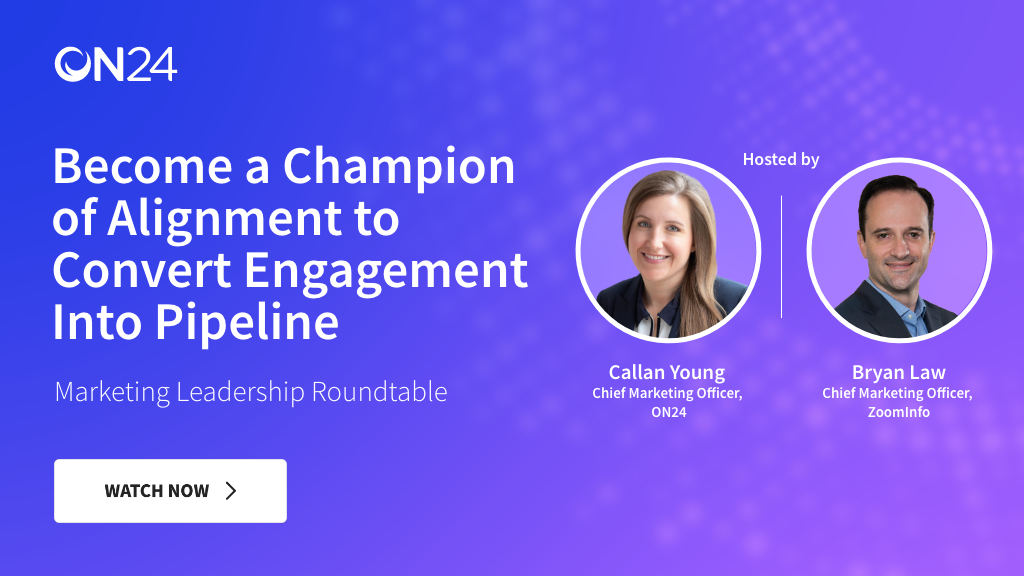5 Marketing Engagement Metrics You Need To Measure Your ROI

For too long, digital marketers have measured the value of their tools and their work based on what is ultimately an arbitrary metric: the qualified lead. And the qualified lead is similarly defined by arbitrary standards, like clicks and touches. It’s time for digital marketers to understand that the traditional benchmarks used to measure success just aren’t built for today’s digital buyers.
It’s time for marketers to stop worrying over ROI and start measuring success with marketing engagement metrics built for today’s digital buyers. And that means being able to measure a return on engagement.
Here’s why.
Why Traditional ROI Metrics Aren’t Enough For Modern B2B Buyers

Traditionally, digital marketers have projected, measured and evaluated success — including return on investment — with metrics and complex formulas designed to track one thing: leads.
In fact, according to an ON24 survey of more than 100 marketing professionals, 60% of respondents say the success of their events is measured either by the number of leads they generated (31%) or by how many sales conversions are initiated (29%).
And that’s not necessarily a bad thing. After all, marketing needs to provide a pipeline to sales and sales needs that pipeline to hit targets. Using metrics to predict the efficacy of generating qualified leads makes sense.
But these measures are imperfect. A visitor that hits a certain threshold of clicks, touches and emails opened doesn’t always mean that lead is qualified to go to sales. In fact, it doesn’t even mean they’re interested in your product.
And things get even trickier when you throw hybrid events into the mix. When asked about their biggest concern with hybrid, 32% percent of survey respondents said it’s “figuring out what a hybrid event model will look like.”
Here’s a reality check: today’s buyers are primarily digital. They prefer to learn about your product and services on their own and when they’re ready, they’ll often reach out to your organization to begin the sales process.
Four Main Traits of Modern B2B Buyers:
1. They are digital-first
According to Gartner, buying groups spend the majority of their buying activities researching solutions online.
2. They are self-educating
With a wealth of resources available, buyers can quickly educate themselves on your products, solutions and standards without hand holding from sales.
3. They consume content on their own
Buyers are busy, meaning they’ll consume content at their own pace.
4. They create their own buying journey
Buying journeys are no longer a straight line from beginning to end. Buyers will jump in and out of your buying process at the drop of a hat.
Today’s qualified buyer isn’t defined by an arbitrary number of actions they’ve taken, but rather how engaged they are in the relationship with your brand.
Why Engagement Is the New Marketing Metric to Measure

The new marketing metric to measure is engagement — an evaluation of how invested a lead is in their relationship with your brand.
Don’t worry: measuring engagement doesn’t mean reinventing the wheel. It’s simply a matter of reengineering how we use the tools we have and rethinking the value of the metrics — clicks, downloads, etc. — currently used in digital marketing.
Let’s take a quick look at the tools that drive digital engagement, so that we can better understand the many benefits of utilizing marketing engagement metrics.
Drive a return on Engagement with Amazing Experiences
Today’s buyers live in a digital world. They Google, they Slack, they email. The advantage marketers have here is that they can often measure a good deal of digital interactions — especially when those interactions take place on owned channels.
But what drives real, genuine digital interactions today? Well, that’s a unified digital experience. And digital experiences aren’t a superficial element — if a visitor comes to your site, they should be able to immediately find the informative content they want to consume quickly and easily.
That content should be presented to them in an engaging way as well. That means providing comprehensive webinars filled with engagement opportunities as well as surfacing relevant content in a content hub.
The goal for the digital marketer today is to create an amazing digital experience that an audience will love, come back to and engage with.
But driving engagement is easier said than done. According to our survey, the most challenging part of running a digital event is getting audiences to engage (55%). How can they overcome this hurdle?
Let’s take a look at the five traits of great digital experiences.
The Five Traits of Great Digital Experiences

1. Branded
Digital experiences are the face of your company. They should share a consistent look, feel and emotional tone and put your brand in the best light. Often, that’ll mean investing in a clean design across your assets and events — from webinars to expo floor booths.
2. Interactive
Digital experiences should be interactive. That doesn’t mean simply allowing visitors to click around your experience and site, but providing them with the opportunity to talk directly with your organization. Chatbots, surveys, polls and webinars are great examples of interactive experiences.
3. Multimedia
Slides, videos — GIFs. Audiences have a lot of options when it comes to consuming content. Your digital experiences need to be just as varied as their tastes to drive engagement.
4. Multi-touch
Great digital experiences surround visitors with lots of content in lots of different ways and let them self-select the content they want to consume. By providing them with multiple options or “touches” we learn more about who they are and what they prefer.
5. Direct engagement
Direct engagement is the ability for your organization to effectively connect and engage with a lead. We’re talking about immediate, near-real-time one-to-one communication with sales and marketing.
Those are the five essential elements of a great digital experience. Now, let’s check out the metrics you’ll need to know to measure the engagement you’ll create.
The Five Key Engagement Metrics to Measure

When it comes to actual engagement metrics, there are five key categories to consider:
1. Time
Time spent on your brand is a significant indicator of engagement. If a lead quickly flips through a blog or an e-book — or even watching a short video — then they’re likely not ready for an outreach email or call.
That’s because short, one-off visits are exactly that: short, one-off visits.
Instead, track the cumulative amount of time an account spends with your digital experiences. Does a lead routinely return to a webinar series? Do they spend time interacting with your five-hour virtual conference? The longer they’re in an experience, the more likely they are to interact with your brand.
2. Touches:
Time gives us touches. That is, the more time spent, the more likely your visitor will interact with the assets — e-books, white papers and case studies — you want them to see. By loading up digital experiences with touch opportunities, you provide visitors with multiple chances to engage with your brand on their own.
3. Interactions
A touch is a good metric to measure. An interaction — whether by filling out a survey, responding to a poll or engaging in a chat — is even better.
Interactions allow marketers to learn something about the lead directly from the lead itself — not through conjecture. Engagement tactics can include one-to-one conversations, polls, surveys, live chat and more.
4. Intent
Marketers love a good intent signal. But a real intent signal isn’t just a click. It’s a cumulative set of actions that lead takes to show you where they are in their buyer’s journey.
The goal for digital marketers here is to cut down on the number of actions a lead needs to take to show intent. Provide audiences with engagement opportunities, like “Talk with Sales” CTAs, embedded demos and additional content.
All of these engagement opportunities can tell you a lot about where a lead is in their journey and how ready they are to take the next step.
5. Actionability
Digital experiences serve one goal: to drive action. All of the intent signals, all of the interactions, the touches and time spent with experiences should inform your marketing and sales teams of what actions need to happen next to accelerate a lead further down the funnel.
Ask yourself: Does the data you’ve gathered throughout your experience provide you with the information you need to take action? Does it tell you where and how you can personalize outreach? Inform sales on what actions they can take?
Optimizing for Return on Engagement

With these engagement metrics in mind, you can begin to optimize digital channels to drive engagement.
As always, sit down with your marketing operations and sales teams to discuss what engagement metrics are the most valuable indicators of a quality lead. As time goes on, you may discover some great insights.
For example, to drive its audience — advisors — to its webinars, John Hancock uses a three-two-one model for webinar emails. Advisors will get an invitation on a particular subject three weeks out from the main event, then a reminder of the event two weeks out and a final reminder a week before the event.
This may seem like a basic engagement strategy, but John Hancock increased conversion rates to its webinars by 25% by following this model. But the company didn’t just optimize its emails. Put together, its digital experiences — especially its webinar program — drove some pretty great results.
By optimizing its experiences, John Hancock:
-
- Drew a 20% increase in meeting interest from cold leads
- Increased sales 5x from webinar attendees alone
- Increased business from virtual event attendees by 266%
- Reached more than 1,500 advisors within the past few months
So, it’s time to start measuring the marketing engagement metrics that matter. Start building your experiences today.

